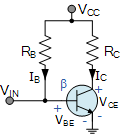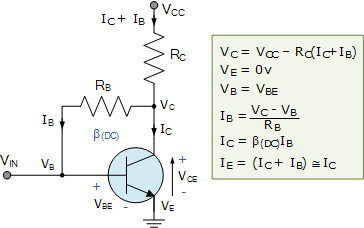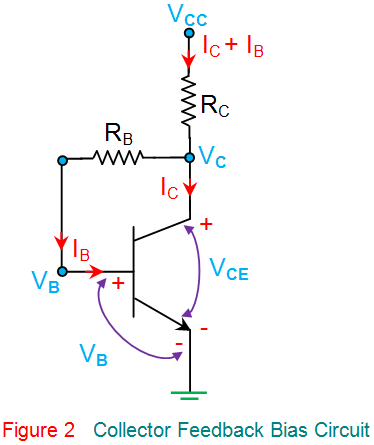What is Transistor Biasing:
Transistor Biasing is the process of setting a transistors DC operating voltage or current conditions to the correct level so that any AC input signal can be amplified correctly by the transistor.

Collector Feedback Biasing a Transistor:

This self-biasing collector feedback configuration is another beta-dependent biasing method that requires only two resistors to provide the necessary DC bias for the transistor. The collector to base feedback configuration ensures that the transistor is always biased in the active region regardless of the value of Beta (β) as the DC base bias voltage is derived from the collector voltage, VC providing good stability.
In this circuit, the base bias resistor, RB is connected to the transistors collector C, instead of to the supply voltage rail, Vcc. Now if the collector current increases, the collector voltage drops, reducing the base drive and thereby automatically reducing the collector current to keep the transistors Q-point fixed. Then this method of collector feedback biasing produces negative feedback as there is feedback from the output to the input through resistor, RB.
The biasing voltage is derived from the voltage drop across the load resistor, RL. So if the load current increases there will be a larger voltage drop across RL, and a corresponding reduced collector voltage, VC which will cause a corresponding drop in the base current, IB which in turn, brings IC back to normal.
The opposite reaction will also occur when transistors collector current becomes less. Then this method of biasing is called self-biasing with the transistors stability using this type of feedback bias network being generally good for most amplifier designs.
Equivalent Voltage and Current in Biasing Circuit:

In this circuit (Figure 2), the base resistor RB is connected across the collector and the base terminals of the transistor. This means that the base voltage, VB and the collector voltage, VC are inter-dependent due to the fact that
![]()
Where,
![]()
From these equations, it is seen that an increase in IC decreases VC which results in a reduced IB, automatically reducing IC. This indicates that, for this type of biasing network, the Q-point (operating point) remains fixed irrespective of the variations in the load current causing the transistor to always be in its active region regardless of β value. Further this circuit is also referred to as self-biasing negative feedback circuit as the feedback is from output to input via RB. However the action of reducing the collector current by base current leads to a reduced amplifier gain. Here, other voltages and currents are expressed as

